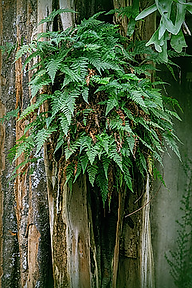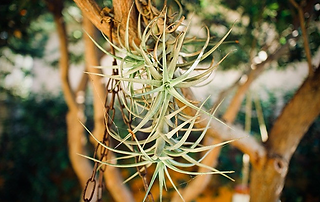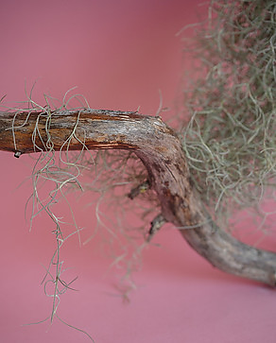
I’m sure you have noticed plants growing without soil. Maybe you’ve been in tropical areas and have noticed beautiful orchids, ferns or Spanish moss growing high in the canopy of trees above the ground. Or perhaps you’ve observed plants seemingly growing out of a rock or on a hard surface like a boat. These types of plants are called epiphytes. So what is an epiphyte? Read on to learn more about epiphytes along with some interesting facts.
(Some of the links within this post are affiliate links on which I receive a small compensation for the sale of certain items.)
(As an Amazon Associate I earn from qualifying purchases.)
What is an Epiphyte?
An epiphyte is a plant that grows on the surface of something for support. It is not a parasite. Unlike parasites which draw nutrients from an organic host, epiphytes get their nutrients from the rainfall, moisture in the air, and decaying organic debris that surrounds them.
Epiphytes attach themselves to structures such as tree bark, moss, rocks, or other solid objects. These structures are used as anchors upon which the roots hold fast.
Different flowers and plants can be classified as an epiphyte but not all epiphytes are related. Epiphytes may be found in most every group of the plant kingdom. In fact, 85% of them are flowering plants.
The term epiphyte only relates to its growth form, not how the plants are related.
Three Types of Epiphytes
There are basically three categories of epiphytes. Each variety is designated according to the origin of its growth.
1. Holo-epithytes: this category refers to those plants that are entirely air-borne. They spend their entire life cycle in the air. Examples are Orchids, Tillandsia (air plants), and certain types of Bromeliads.

2. Hemi-epiphytes: these plants spend only part of their life cycle as epiphytic. Their seeds germinate in the canopy of trees and eventually their roots contact the ground. An example of this is the strangler fig. It begins its life in the tree but eventually roots in the ground. It then entangles itself up the tree and will eventually strangle it.
3. Epizoic epiphyte: epizoic plants live and grow on the external surface of an animal. Examples are fungi, mosses, barnacles and algae.
General Information on How to Grow Epiphytes
These instructions pertain to holo-epiphytic plants; those growing without soil. For more in depth instructions of how to grow and attach an epiphyte of the Bromeliad family to an anchor, click Epiphytic Plants.
1. You want to simulate the plant’s natural environment. Therefore, find a supportive branch to which the plant can attach its roots.
– In addition to a branch, you can also use a container such as a hanging basket or a small bowl filled with bark or lava rocks.
– Dead wood such as driftwood or cork can also be used.
– Epiphytes DO NOT grow on bare wood. You need to supply a medium which will collect seeds, water, and other nutrient rich debris.
2. Supply a soilless medium such as moss, coconut coir, wood chips or fiber to hold moisture.
– DO NOT use peat moss. It is highly acidic. (A few varieties of epiphytes do like high acidity so research the variety of epiphyte you are purchasing and adapt from there.)
– Sphagnum moss is a good medium because it has a neutral pH.
– Buy the moss or coconut coir from a reliable source. Some mosses and coirs are illegally sourced which can be detrimental to the environment.
– Coconut coir harvested from coconut has a neutral pH. Purchase processed coir where its chemicals and salt have been removed. Purchase Compressed Block Premium Coconut Coir Husk from Amazon.
Prococo Compressed Coconut husks are a good choice.
Purchase from Amazon: Prococo Cocopeat
Compressed coco chips from Vivilly is a good medium for holo-epiphytes.
Purchase from Amazon: Vivlly Compressed Coco Coir Bricks, 5 Pack, Natural Seed Starter

Peat Moss VS Sphagnum Moss
Peat moss and sphagnum moss are the same plant. However, sphagnum moss is the live part that grows on soil.
Peat moss is dead compacted sphagnum moss which has decayed and decomposed for centuries. It is not sustainable since it contains few, if any nutrients. Sphagnum moss has nutrients and is friendlier to the planet.
Interesting Facts Regarding Epiphytes
The term epiphyte is a Greek word epi – meaning upon and phyton – meaning plant hence, growing upon a plant.
Epiphytes can be found in temperate zones between the Tropic of Cancer and the Arctic in the northern hemisphere and the Tropic of Capricorn and the Antarctic in the southern hemisphere. These zones have wider temperature ranges where you would experience cold winters, hot summers, and moderate springs and falls. Examples of these would be lichens, algae and many mosses.
Epiphytes can also be found in tropical zones. Some ferns, orchids, cacti (such as Christmas cacti), and bromeliads grow well in the tropics.
Air plant epiphytes, also known as Tillandsia, are easy to grow. Try growing them on driftwood.
What is an Epiphyte??
After reading this explanation of what an epiphyte is, I’m sure you’ll be able to impress the next gardener you encounter! Epiphytes are any plants that do not necessarily need soil to grow. They only need an anchor for their roots to grasp, water in the form of mist or rainfall, and nutrients supplied by a suitable medium and/or fallen natural debris.
I hope you enjoyed this post. I’d love to hear from you. Please leave a comment below and share it with others using the social media icons.
Happy Gardening!
Nina
